On the east coast of Sardinia, 90 minutes drive south of Cala Gonone, and 2.5 hours drive from the island's 3 main airports of Alghero, Olbia and Cagliari, is Ogliastra, Sardinia's wildest and least developed province. While the climbs around Jerzu have been developed since 1997 and continue to offer superb year-round steep limestone climbing, mostly at grade 6b or higher, the recent development of sport climbs around Baunei has added both slabby and overhanging climbing overlooking the sea. Here you will find a reasonable number of 5's and easy 6's, as well as harder routes, all on fantastic rough limestone.
The Baunei area offers as well long, hard (6b obligatory and harder) multi-pitch routes on the stunning cliffs of the Aguglia pinnacle at Cala Goloritze and Punta Giradili and Regno dei Cieli. Add the sun-trap of Quirra, 1 hour by car south of Ogliastra, and the granite boulders litter the countryside, from sea level up to 1000m, and you have a superb year-round climbing area. When you consider as well the fantastic settings of the crags, great walking and biking, and proximity of miles of beaches and the Mediterranean's cleanest seas - deserted except in August - plus cheap pizzas and wine, you see why this is an area that adventurous Germans and Swiss in their camper vans have already discovered, but that British climbers are only just starting to explore.
Jerzu
Two crags, Castello and Isola del Tesoro facing west, and Palazzo d 'Inverno facing east at 450m altitude, with over 200 one-pitch sport routes, mostly from 6a upwards with steep, fingery and technical climbing on superb rock. The holds at Il Castello are more rounded than those at the other nearby crags and there are lots of pockets to explore before you find the best holds, making the routes more technical compared to Palazzo with its in-cut holds and the fantastic concretions of the right-hand section of the crag which is reminiscent of the Eliminates Wall at Curbar. From Isola del Tesoro you have a fantastic view over the limestone countryside with its 'taccu' (heels) - the limestone escarpments that stick up everywhere.
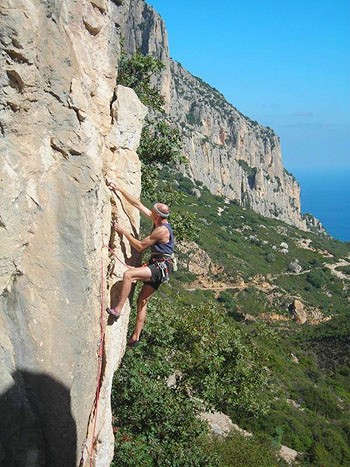
Baunei - single pitch routes
Apart from some short and, in some cases, excellent and not-too-hard routes in the sheltered port of Santa Maria Navarrese, the Baunei climbs are situated around the road off the SS125 - Orientale Sarda - leading down to the sea stack of Pedra Longa. Over 120 single pitch sport climbs on fantastic limestone, with 8 5's through to 7b/c overhanging testpieces. Villaggio Gallico has slabs and a steep headwall. Next door Creuza de Ma has slabs and a bulging central section with some short and disperate testpieces, while the Ichnusa sector at Campo dei Miracoli has slabs on which you can smear like you're on gritstone.
Auguglia and Punta Giradili - multi-pitch climbs
The easiest routes up the Auguglia pinnacle at Cala Goloritze are Easy Gymnopedie 5 pitches (140m 6b max, 5c obl) or the original route, the 165m Sinfonia dei Mulini a Vento (sport 6b+/5c obl. UK E2 5c since a full rack is needed) - see the Rockfax guide to Cala Gonone.
At Punta Giradili (see photo) the easiest routes up the pillar right of the big cave are Mediterraneo (240m max 7a+/6b obl.) and Wolfgang Güllich (400m max 7a/6b obl.) Although bolt protected, these are long, hard and serious routes on which the bolts can be further apart than on the single-pitch crags and retreat can be difficult. To avoid getting psyched-out, we recommend a recce, approaching from the bottom via the old charcoal burners' path that traverses the grass ledge just below the main crag - truly spectacular!
Bouldering
The countryside is littered with granite boulders, although often when they are high enough to offer decent problems, the landing is very slopy. The problems in the Bosco Selene wood at 1000m are described in Pietra di Luna. Take a brush. In the winter we go to the granite boulders by the sea 500m from our flat at Porto Frailis. The boulders are entirely free of moss and lichen, and have flat landings on the rocky shelves above the sea.
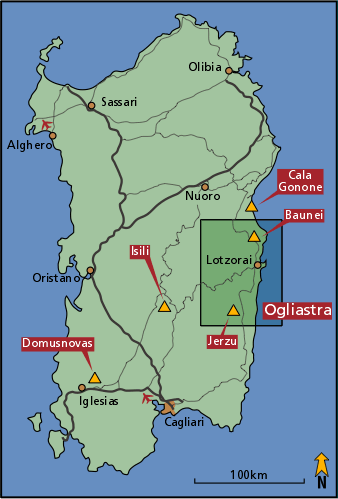
Weather
Ogliastra's mild climate - 7°C on average warmer than London and just 2°C cooler than the Costa Blanca - means you can climb all year round. In winter (max 15°C min 6°C) we go to the sunny, sheltered, south-facing crags at the port of Santa Maria Navarrese, Ichnusa or Quirra.
Villaggio Gallico, Creuza de Ma and Jerzu all offer shade, and you can climb there even with the 30-35°C summer temperatures. From May to October it is as dry as southern Spain. In the period November - March the monthly rainfall is the same as that in the English spring and summer, but the rain falls in heavy showers, after which the sun and wind soon dry out the crags and you will soon be climbing again.
Accommodation
We are completing the fitting-out of a big house in Lotzorai, 1.5 km from the sea, and by June 2007 our centre for climbers, cyclists and walkers should be open, offering B&B accommodation for 9 people for around €35-30 pppn, lunch/dinner several days a week and lots of logistical support to make the most of your time in Ogliastra. We also rent out an apartment only 200m from the beach in Porto Frailis at Arbatax. The price to rent the flat depends on the season, from €165 per week in winter to €420 in July and €675 in August. We can also help you find other apartments in the area if ours is already full.
There are lots of restaurants, with prices ranging from €10 for a pizza and beer to €25 for a 3-course meal with wine. The local pecorino cheese, roast suckling pig and Cannonau wine are not to be missed.
Car Rental
For a 9-day period, car hire costs about €300 for a Punto or Fiesta; about €400 for a Golf, Astra or Focus; and about €500 for a Passat, Megane or Vectra. Contact us if you want details of the best route to drive from the airport.
Cycling/Mountain-biking
Peter is into serious road cycling (granfondo racing) and the superb training provided by the Ogliastra region was one of the main reasons we moved there. The mountains rise directly from sea level to over 1100 metres in less than 30km, offering you a range of superb training rides for road cyclists with hardly any traffic on mostly-perfect roads and stunning scenery. There is also lots of mountain-biking. We have a van so we can help cyclists transport their bikes and bike boxes from the airport so they don 't have to hire a big car for the whole week.
Beaches/water-sports
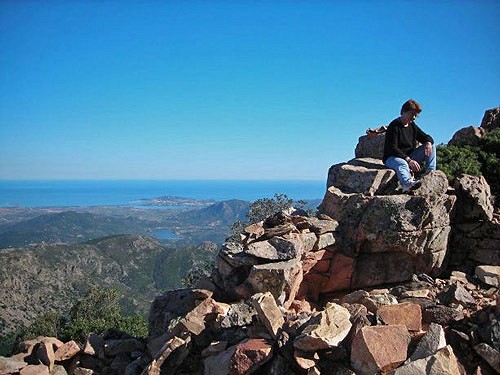
Sardinia is incredibly beautiful and each year many tourists come especially for its clear sea and beautiful beaches. The sea in Sardinia is famous for its clarity and the beaches regularly win prizes for being Italy 's cleanest. You can swim, canoe, dive and sail around the island all year.
Walking
Walking in Sardinia is fantastic, and the Ogliastra region offers some of the best and most varied walks, with hundreds of routes for walkers, ranging from spectacular coastal walks - from the many easy walks to the Sentiero Selvaggio Blu, a multi-day expedition involving climbing and abseiling, as well as walks on the Gennargentu mountains overlooking Ogliastra. The highest point, Punta La Marmora, 1834m, is reached by en easy walk but in summer do take enough water for a 5-hour round trip. We failed to do this when we went.
Culture and Sightseeing
Over the centuries the coasts of Sardinia were attacked by Carthagians, Romans, Spaniards, Tuscans andand until after WW2 and the American 's DDT spraying were malarial. To escape these twin threats, the Sards retreated into the mountains and developed an economy heavily based on sheep farming. The interior of the island is dotted with Neolithic forts called Nuraghe and there are some scary pagan fertility dances. The people have a resilience and stoicism more reminiscent of Scots than Italians. Leave enough time between your cranking and dynoing to check this out.
Getting to Sardinia from the UK
Ryanair fly year-round to Alghero from Stansted and Liverpool, and in summer from East Midlands. Easyjet and BA fly to Olbia and Cagliari from April to October. From each of these airports it is 2.5 hours drive to Ogliastra.
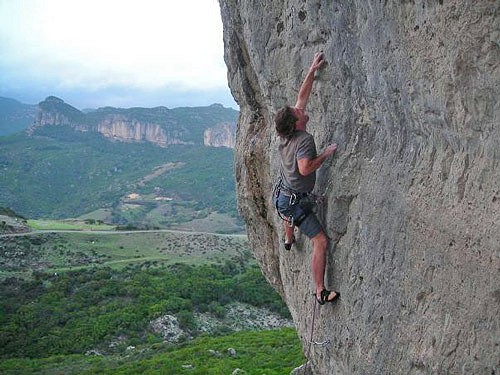
UKClimbing.com asked Peter some questions about this new climbing area
Does the area get many climbing visitors?
No, frequently we have the crags to ourselves, except maybe in May or October there are some Germans, Austrians or Swiss. The odd British climber ventures to Jerzu during a trip to Cala Gonone. There are huge limestone walls still to be developed, Sardinia's hardest sport climbs have just been put up on the Braccio di Ferro sector across the road from Villaggio Gallico and lovely granite boulders fill the woods and you won 't have to queue.
How does the climbing compare to Cala Gonone and Dorgali, or with the inland Sardinia areas of Domusnovas and Isili?
We find that Ogliastra is much less busy than Cala Gonone, you really feel you are in unspolit countryside. Often we have the crag to ourselves. Except at the Castello at Jerzu where the softish rock in places has got a bit worn by climbing, at least on the routes nearest the road, the rock is much less polished than at Cala Gonone. We used to think that you had to go to Cala Gonone to be able to climb when it's raining, but since we discovered Quirra we go there, provided it's not raining too hard; it's nearer and the drive is much less tortuous. The range and proximity of the crags to one another isn't quite as great as that at Domusnovas - there are no mega-tufas around here, like those at the Grotta di San Giorgio - but apart from this we have slabs, walls and overhangs, with lots of 5's and 6's and everything upwards.
What are the best guidebooks and sources of information on the routes?
Maurizio Oviglia 's Pietra di Luna guidebook (2004, next edition in 2009 and I've agreed to help Maurizio with the translation into English) to the whole of Sardinia contains inspiring photos and is a must-have. The grades are maybe one-half a sport grade easier than Rockfax's grading for Cala Gonone and Dorgali.
We have put together on our site www.peteranne.it with some additional descriptions of how to find the climbs as well as downloadable topos, and we keep this up-to-date. We are also building a database of the climbs Peter has done over the last year since we lived here, and his comments.
The excellent site www.sardiniaclimb.com in Italian and English has lots of news about recent developments, and there are magazine articles as well. For instance, the Oct-Nov 2006 edition of the Italian magazine Alpe Wall has a big article on the sea-cliff climbs in the Golfo di Orosei, between Cala Gonone and Baunei.
What's the bouldering like, much potential?
I 'm not the best person to ask and in my formative years bouldering was for days too cold too stand and belay, we psyched up for on-sights, mats didn 't exist andso I can 't give a complete answer and prefer onsighting (or trying to onsight and) routes. The boulders at Torre San Gemiliano are great for a winter afternoon, and it 's a beautiful spot to hang out. I 'm sure that, among the loads of boulders that litter the countryside, many offer good climbing, it 's a case of checking them out, cleaning and so on.
Is there any deep water soloing?
The crags mentioned aren't right above the sea. In so far as the whole 60 km of coastline from Cala Gonone to Baunei is accessible only by boat or on foot - there are no roads - there may be DWS's, there are some threads on the Sardinian climbing forums about DWS.
Do you need to rent a car? And if not how can climbers be get to your place from the airport?
For a week, we recommend you rent a car to get the best out of your time. From our house it 's only 10 mins by car to the Baunei crags but 30 mins onto the Golgo plateau to walk to Punta Giradili and Cala Goloritze, 45 mins to Jerzu and 60 mins to Quirra. Getting around without a car is very slow.
Feedback
Peter Herold has kindly offered to answer any questions about climbing in Ogliastra on the forum thread about this article.

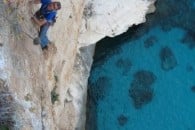

Comments